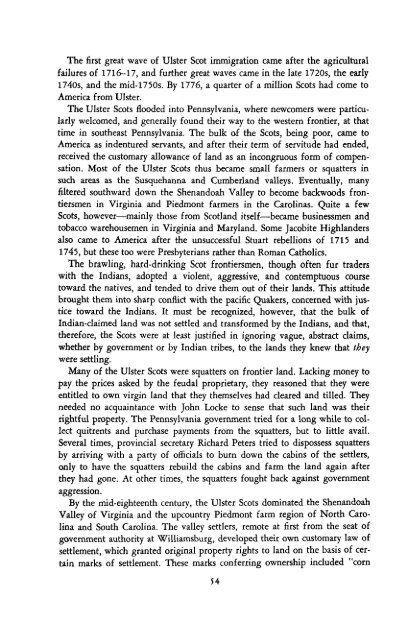Conceived in Liberty Volume 2 - Ludwig von Mises Institute
Conceived in Liberty Volume 2 - Ludwig von Mises Institute
Conceived in Liberty Volume 2 - Ludwig von Mises Institute
You also want an ePaper? Increase the reach of your titles
YUMPU automatically turns print PDFs into web optimized ePapers that Google loves.
The first great wave of Ulster Scot immigration came after the agricultural<br />
failures of 1716-17, and further great waves came <strong>in</strong> the late 1720s, the early<br />
1740s, and the mid-l75Os. By 1776, a quarter of a million Scots had come to<br />
America from Ulster.<br />
The Ulster Scots flooded <strong>in</strong>to Pennsylvania, where newcomers were particularly<br />
welcomed, and generally found their way to the western frontier, at that<br />
time <strong>in</strong> southeast Pennsylvania. The bulk of the Scots, be<strong>in</strong>g poor, came to<br />
America as <strong>in</strong>dentured servants, and after their term of servitude had ended,<br />
received the customary allowance of land as an <strong>in</strong>congruous form of compensation.<br />
Most of the Ulster Scots thus became small farmers or squatters <strong>in</strong><br />
such areas as the Susquehanna and Cumberland valleys. Eventually, many<br />
filtered southward down the Shenandoah Valley to become backwoods frontiersmen<br />
<strong>in</strong> Virg<strong>in</strong>ia and Piedmont farmers <strong>in</strong> the Carol<strong>in</strong>as. Quite a few<br />
Scots, however—ma<strong>in</strong>ly those from Scotland itself—became bus<strong>in</strong>essmen and<br />
tobacco warehousemen <strong>in</strong> Virg<strong>in</strong>ia and Maryland. Some Jacobite Highlanders<br />
also came to America after the unsuccessful Stuart rebellions of 1715 and<br />
1745, but these too were Presbyterians rather than Roman Catholics.<br />
The brawl<strong>in</strong>g, hard-dr<strong>in</strong>k<strong>in</strong>g Scot frontiersmen, though often fur traders<br />
with the Indians, adopted a violent, aggressive, and contemptuous course<br />
toward the natives, and tended to drive them out of their lands. This attitude<br />
brought them <strong>in</strong>to sharp conflict with the pacific Quakers, concerned with justice<br />
toward the Indians. It must be recognized, however, that the bulk of<br />
Indian-claimed land was not settled and transformed by the Indians, and that,<br />
therefore, the Scots were at least justified <strong>in</strong> ignor<strong>in</strong>g vague, abstract claims,<br />
whether by government or by Indian tribes, to the lands they knew that they<br />
were settl<strong>in</strong>g.<br />
Many of the Ulster Scots were squatters on frontier land. Lack<strong>in</strong>g money to<br />
pay the prices asked by the feudal proprietary, they reasoned that they were<br />
entitled to own virg<strong>in</strong> land that they themselves had cleared and tilled. They<br />
needed no acqua<strong>in</strong>tance with John Locke to sense that such land was their<br />
rightful property. The Pennsylvania government tried for a long while to collect<br />
quitrents and purchase payments from the squatters, but to little avail.<br />
Several times, prov<strong>in</strong>cial secretary Richard Peters tried to dispossess squatters<br />
by arriv<strong>in</strong>g with a party of officials to burn down the cab<strong>in</strong>s of the settlers,<br />
only to have the squatters rebuild the cab<strong>in</strong>s and farm the land aga<strong>in</strong> after<br />
they had gone. At other times, the squatters fought back aga<strong>in</strong>st government<br />
aggression.<br />
By the mid-eighteenth century, the Ulster Scots dom<strong>in</strong>ated the Shenandoah<br />
Valley of Virg<strong>in</strong>ia and the upcountry Piedmont farm region of North Carol<strong>in</strong>a<br />
and South Carol<strong>in</strong>a. The valley settlers, remote at first from the seat of<br />
government authority at Williamsburg, developed their own customary law of<br />
settlement, which granted orig<strong>in</strong>al property rights to land on the basis of certa<strong>in</strong><br />
marks of settlement. These marks conferr<strong>in</strong>g ownership <strong>in</strong>cluded "corn<br />
54
















